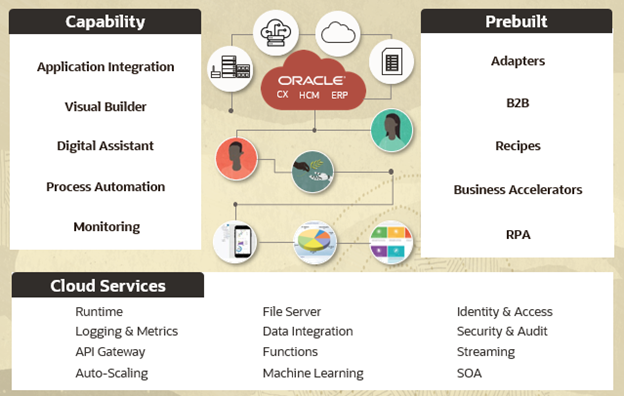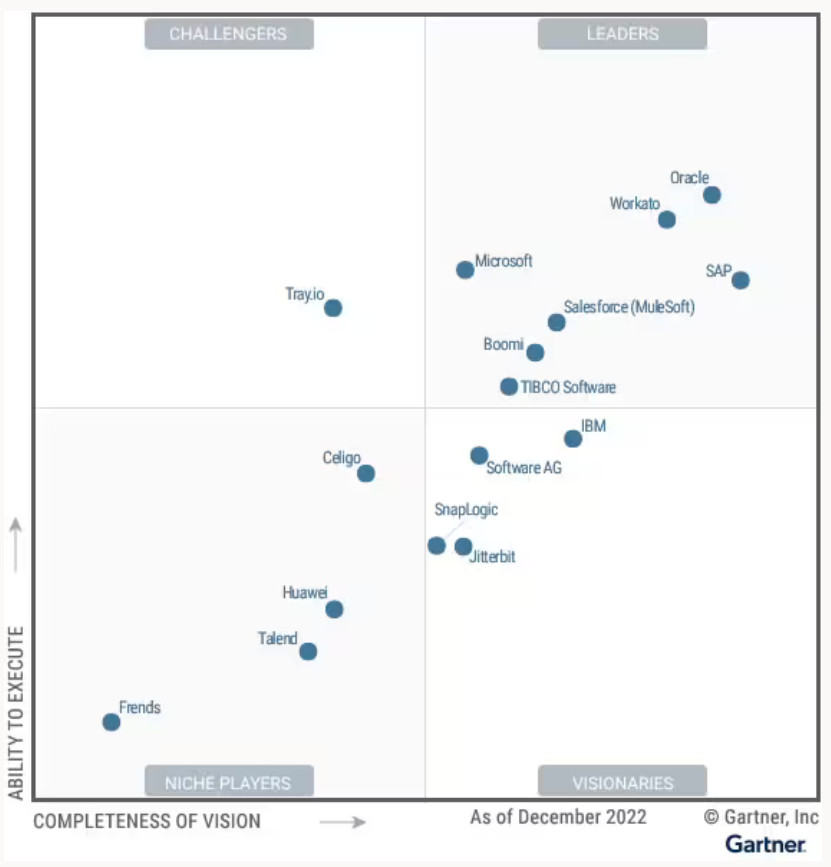Prebuilt Oracle Applications Integrations
We are glad to see you came back to learn about the last part of Oracle’s approach to Oracle Cloud Application integration. In this post, we will continue our series on Oracle Cloud Applications technology and examine external integration with Oracle Cloud Applications. In our previous post, we explored the comprehensive integration frameworks and functionality included out-of-the-box with Oracle Cloud Applications. These include bulk data loads, bulk data extracts, report data extracts, spreadsheet integration support, inbound/outbound rest APIs, inbound/outbound SOAP web services, and B2B integration support. Next, we will look at prebuilt integrations that have been created using these frameworks and discuss how you can create your own integrations using these frameworks as well.
Because the same common integration requirements often exist for multiple customers, Oracle or third-party Oracle Partners will often build reusable integrations to address those common requirements. The integrations are created using the included Oracle Cloud Application integration frameworks listed above and described in our previous blog post. Prebuilt integrations allow reuse by any organization that chooses to leverage them, and they can typically be enabled through a simple setup and configuration process.
Not only do prebuilt integrations involve a simple setup process, but additionally they have been reviewed and validated by Oracle Engineering so that customers can have confidence in all aspects of their functionality. Once interfaces are created, Oracle or the third-party vendors who have created them often make them available for purchase on the Oracle Cloud Marketplace.
Many Oracle Cloud Applications prebuilt integrations have been created, and the following is a small sample of some that exist:
- Oracle Cloud HCM: Payroll systems, benefit providers, background check applications, etc.
- Oracle Cloud Financials: Banks, sales taxes, use taxes, travel systems, exchange rates, etc.
- Oracle Cloud Supply Chain Management: Quote data, order data, warehouse RF device integration, labeling devices, etc.
In addition to these, an extensive set of prebuilt integrations has also already been created. Nevertheless, customers still sometimes have requirements to build integrations that are unique for their business or industry.
Creating Integrations Using Oracle Integration Cloud
When customers find themselves needing to create their own unique integrations, such as for connecting to a custom application, customers can leverage the frameworks described in our previous post and included with Oracle Cloud Applications for that purpose. And because included Oracle Cloud Application integration frameworks are open and based on industry standard protocols, these frameworks can be easily accessed by external, third-party middleware tools and services. However, if customers need a middleware tool for this or any other aspect of interface development, Oracle Integration Cloud (OIC) represents a great option.
OIC can save customers considerable work, eliminate the need for manual coding, and significantly simplify interface design and creation. Plus, because OIC is an Oracle Infrastructure Platform Service, it is built using many of the same technologies as Oracle Applications. This ensures compatibility with Oracle Cloud Applications both now and in the future.
Oracle Integration Cloud (OIC) streamlines the interface creation process by providing, among other things, a visual development experience, a built-in mapping functionality, and a graphical interface orchestration functionality. OIC also includes an sFTP server that customers can leverage when setting up inbound or outbound integrations. More specifically, OIC includes the following:
Recipes – Downloadable sample or template integrations that can be used as guides when creating integrations. Recipes provide customers with a head-start for creating specific example integrations for frequently occurring use cases.
Accelerators – Fully built downloadable integrations for common use cases. Accelerators are ready-to-run after completing minimal setup and configuration.
Recipes and accelerators can be authored either by Oracle or by third-parties. In the case of accelerators, these are supported going forward by the authoring party. For more information on recipes and accelerators, please refer to the following:
Oracle Integration Cloud recipes and accelerators
Additionally, both recipes and accelerators are downloadable from within the Oracle Integration Cloud service or from the Oracle Cloud Marketplace previously described.
Adapters – Prebuilt application constructs for streamlining the connectivity to pre-defined applications, databases, and other technology sources. Connection wizards simplify the interface development process by cataloguing interfaces and reading schema definitions from supported sources.
Events – A feature that can be uniquely leveraged by Oracle Integration Cloud (OIC), event usage gives customers exclusive access to business events within Oracle Cloud Applications including for example, the creation of a supplier, purchase order, or shipment request. After subscribing to one of these events, OIC can trigger any number of downstream actions such as launching an inbound interface, sending data to an external application, or creating additional records elsewhere for additional further processing. The real-time nature of event subscriptions minimizes business disruptions, eliminates synchronization errors, and prevents delays associated with traditional triggering methods such as polling.
Insight – Oracle Integration Cloud (OIC) provides customers with both technical and business end-to-end enterprise data flow visibility. Customers can see the number of transactions from a source system and customers can also quantify transactions in business terms. This includes, for example viewing sales import volume by order type.
B2B EDI Support – This functionality augments the native Oracle Applications Collaborative Messaging Framework (CMK) described in our previous post. OCI B2B EDI support adds the ability to translate messages between OAGIS XML format and EDI.

Figure 1: Oracle Integration Cloud (OIC) functionality for Oracle Cloud Applications
Additionally, with the latest version of Oracle Integration Cloud (OIC), customers can now create and organize multiple integrations into a project within OIC. An integration project represents a way to bundle a set of self-contained assets (integrations, connections, lookups, and custom functions) into a single solution that customers design, manage, and monitor as a single unit from a single workspace. Organizing assets into projects significantly enhances visibility, development, and observability while streamlining integration delivery management. Furthermore, pre-built integration assets organized into an OIC accelerator can now be delivered and more easily and updated together when organized as project assets.
Summary
As you can see, Oracle Integration Cloud (OIC), when used with Oracle Cloud Applications, extends native application functionality and streamlines the interface creation process. Furthermore, OIC saves customers a significant amount of work as they connect their applications to external endpoints. Click here for additional information on Oracle Integration Cloud.
As noted previously, Oracle Integration Cloud (OIC) has been named a Leader and positioned highest for Ability to Execute in the 2023 Gartner® Magic Quadrant™ for Integration Platform as a Service. For more information on this, please refer to the link and diagram below:

Figure 2: 2023 Gartner® Magic Quadrant™ for Integration Platform as a Service, Worldwide.
And finally of course, when using multiple Oracle Cloud Applications, especially the comprehensive Oracle Fusion Cloud Applications, integration between the different functional business areas is prebuilt and out-of-the-box. This is because the Oracle Cloud Applications are a single, consistent, and comprehensive solution that does not even require integration. After all, the easiest integration is the one that you don’t have to build!
Thank you for coming along on this three-part journey on Oracle Cloud Application integration. For more great information on why technology matters for Oracle Cloud Applications, be sure to come back for future posts to this blog. And for further information on integration for Oracle Cloud Applications, be sure to check out any of the following:
Gartner, Magic Quadrant for Integration Platform as a Service, Worldwide, 24 January 2023, Keith Guttridge | Andrew Comes | Saikat Ray
Gartner does not endorse any vendor, product or service depicted in its research publications, and does not advise technology users to select only those vendors with the highest ratings or other designation. Gartner research publications consist of the opinions of Gartner’s research organization and should not be construed as statements of fact. Gartner disclaims all warranties, expressed or implied, with respect to this research, including any warranties of merchantability or fitness for a particular purpose.
This graphic was published by Gartner, Inc. as part of a larger research document and should be evaluated in the context of the entire document. The Gartner document is available upon request from Oracle.
GARTNER is a registered trademark and service mark, and MAGIC QUADRANT is a registered trademark of Gartner, Inc. and/or its affiliates in the U.S. and internationally and are used herein with permission. All rights reserved.
The authors are members of Oracle’s North American Applications Advanced Technology team, dedicated to helping customers modernize their businesses through technical innovation. They provide subject matter expertise and vision on SaaS, platform technology, operations, and data management.

